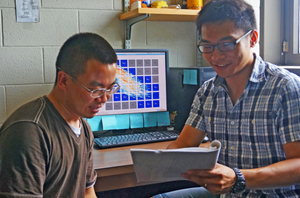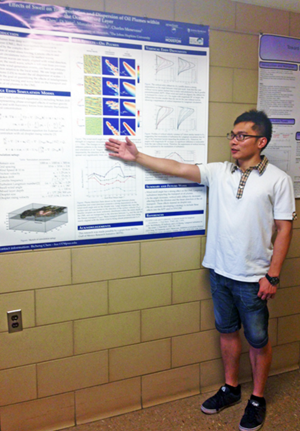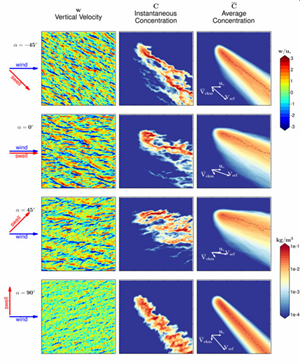
Bicheng at Pennsylvania State University works on the coding for simulations involving oil plumes. (Provided by Bicheng Chen)
Bicheng Chen is dedicated to seeking the physical explanations behind everyday phenomena. His research on ocean turbulence and numerical modeling led him to investigate the interactions among wind, waves, and turbulence and their effect on oil transport and dispersion.
Bicheng is a meteorology Ph.D. student at Pennsylvania State University and a GoMRI Scholar with the project Large Eddy Simulation of Turbulent Dispersion of Oil in the Ocean Surface Layers: Development, Testing and Applications of Subgrid-Scale Parameterizations. He discussed his research and reflected on his academic journey.
His Path
Bicheng’s childhood dream of becoming a scientist began by watching spacecraft on television and grew after his first middle school physics class. He explained his fascination, “Physics is one of the only ways we can describe the phenomena we observe in our world.” Bicheng completed a physics undergraduate degree at Peking University and joined their atmospheric physics masters’ program, where he developed an interest in fluid mechanics and numerical modeling.
After completing his master’s degree, Bicheng contacted Dr. Marcelo Chamecki, a Penn State University meteorology professor, hoping to join his team researching turbulence – the continuous change in magnitude and direction of a fluid’s flow. Chamecki, working with Johns Hopkins University’s Charles Meneveau, had a research position available to track and predict oil dispersion in the ocean mixed layer. Bicheng happily joined Chamecki’s lab as a Ph.D. student, “Life in academia is very exciting,” he said. “My understanding of fluid dynamics and numerical modeling has been growing rapidly.”
His Work

Bicheng (right) discusses his research with a colleague. A new technique that he is using to track oil plumes is visible on the monitor behind them. (Provided by Bicheng Chen)
Turbulence can cause vertical mixing of oil that forms a continuous plume, which helps disperse oil into the water column for microbial consumption. However, wind-wave interactions can also create Langmuir circulations, which are counter-rotating vortexes near the ocean surface that can affect the vertical mixing of oil. Langmuir circulations converge strong forces on the water’s surface and below that push small oil droplets into deeper waters and constrain large droplets at the surface.
Bicheng uses large-eddy simulations to examine oil plume evolution and the flow of the mixed ocean layer under varying wind speeds, wave characteristics, and oil droplet sizes. These simulations help him to visualize swell waves and see their effect on oil dispersion. “As this project evolves, I feel we are able to better understand the physical processes governing oil slick transportation and dilution in the ocean mixed layer,” he said. He hopes that his findings can help improve large-scale models used to predict oil transport and develop contingency plans.
His Learning

Bicheng displays a poster detailing his research at Pennsylvania State University. Bicheng and his advisor Dr. Marcelo Chamecki created this poster, which was presented at the 2015 Gulf of Mexico Oil Spill and Ecosystem Science Conference. (Provided by Bicheng Chen)
Bicheng is honored to conduct research alongside experts in his field. In addition to working with his advisor, Bicheng communicates frequently with Meneveau and Di Yang (University of Houston), “Our team members have a profound understanding of fluid mechanics, and our weekly teleconferences have contributed immensely to my learning experience.” He has enjoyed meeting with scientists in other disciplines at the annual Gulf of Mexico Oil Spill and Ecosystem Science Conference. He said it was exciting to see many different research fields brought together by the Deepwater Horizon oil spill. He added, “I especially enjoyed explaining my work to other scientists who are interested in addressing the same problem from a different perspective.”
Bicheng is thankful that his parents have always encouraged him to pursue his dream and supported his decisions, even when those took him far from his home in China. He explained that when his father was a young man, he had an opportunity to further his academic career but could not pursue it because his parents wanted him close to home. “When my time came, my father did not hold me back. Instead, he wanted me to go as far as I could,” says Bicheng.
His Future
Bicheng plans to pursue a post-doc position after he completes his Ph.D. and hopes to teach. He remarked that wherever his future takes him, he wants to continue learning new things and expand his knowledge of his field.
Praise for Bicheng

A figure from Bicheng’s poster. The figure depicts vertical velocity near the ocean surface (left column), instantaneous oil surface concentration (middle column), time-averaged oil surface concentration (right column), and the direction of wind stress and swell (arrows). It suggests that the angle between wind and swell has profound effects on the orientation and strength of Langmuir circulations (red/blue bands in left column), which causes different patterns in instantaneous surface plumes. (Provided by Bicheng Chen)
Meneveau, the project’s principle investigator, described Bicheng as a great asset. He praised his “can do” attitude and explained that his most impressive quality is his ability not only to conduct large simulations but also to extract insights and meaningful knowledge from them. “He showed results and then told us what they meant,” said Meneveau. “We were always able to have our discussions at a deep, conceptual level and concentrate on the physics rather than getting hung up on the technical details.”Chamecki said that Bicheng’s great personality and creative work have surpassed expectations, explaining that few graduate students can contribute to their project like he has. Chamecki recalled lamenting to Bicheng about the limitations of their numerical algorithm. “Bicheng had an idea to make the code run more quickly and it developed into an entirely new line of investigation that became an integral part of our project,” Chamecki explained. Looking back at Bicheng’s contributions, Chamecki believes that he has a successful science career ahead of him.
The GoMRI community embraces bright and dedicated students like Bicheng Chen and their important contributions. The GoMRI Scholars Program recognizes graduate students whose work focuses on GoMRI-funded projects and builds community for the next generation of ocean science professionals.
Learn more about this research on the Atmospheric Boundary Layer and Turbulence Research Group (Penn State) and Turbulence Research Group(Johns Hopkins) websites.
This research was made possible in part by a grant from BP/The Gulf of Mexico Research Initiative (GoMRI) to the Large Eddy Simulation of Turbulent Dispersion of Oil in the Ocean Surface Layers: Development, Testing and Applications of Subgrid-Scale Parameterizations. The GoMRI is a 10-year independent research program established to study the effect, and the potential associated impact, of hydrocarbon releases on the environment and public health, as well as to develop improved spill mitigation, oil detection, characterization and remediation technologies. An independent and academic 20-member Research Board makes the funding and research direction decisions to ensure the intellectual quality, effectiveness and academic independence of the GoMRI research. All research data, findings and publications will be made publicly available. The program was established through a $500 million financial commitment from BP. For more information, visit http://gulfresearchinitiative.org/.
